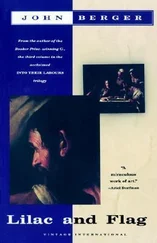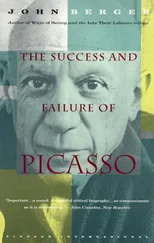He stands beside Picasso. Picasso is the painter of today; his greatness rests on the vitality with which he expresses our present conflicts. Léger is the painter of the future. And by that I do not simply mean that his future as an artist is assured, but that he assures his audience, if they have the courage to accept it, of their future. Yet at the same time Léger was not Utopian. He recognized human vulnerability and allowed for it by the tenderness of gesture and mood of his figures. In a Utopia there might be gaiety and co-operation and happiness but there would be no need for tenderness, for tenderness is the result of understanding human weakness. His Constructeurs do not only build together: they also protect one another — as, in practice, men working on high scaffolding must. His portrait of Eluard shows all the doubting that a lyrical poet must undergo. In one of his last canvases, called Maternité , the typical bands of bright colour set the drawing flying, as gay as a tricolour, but the daughter’s hand touches her mother’s cheek with the necessary reassurance that children can give. Such tenderness is not innocent.
1954
Because Picasso holds the position he does, every misinterpretation of his work can only increase contemporary misunderstanding of art in general. That is the justification for adding a few more hundred to the millions of words through whose mesh he himself always escapes.
Above all Picasso suffers from being taken too seriously. He recognizes this himself and it is one of the ironical themes of some of his drawings. The indignant take him too seriously because they attach too much importance to the mad prices his works fetch and so assume that he — instead of his hangers-on — is a racketeer. The ostentatiously tolerant take him too seriously because they forgive him his excesses on the ground that, when he wants to be, he is a great draughtsman. In fact this is untrue. His best drawings if compared to those of Géricault, Daumier or Goya appear brilliant but not profound. Picasso’s future reputation as a great artist would not, as is so often said, be guaranteed by his realistic works alone. The enthusiastic take him too seriously because they believe that every mark he has made, the date on which he made it and the address he happened to be living at, are of sacred significance. The critical minority in the Communist Party take him too seriously because they consider him capable of being a great socialist artist and assume that his political allegiance is the result of dialectical thinking rather than of a revolutionary instinct.
In front of Picasso’s work one pays tribute above all to his personal spirit. The old argument about his political opinions on one hand and his art on the other is quite false. As Picasso himself admits, he has, as an artist, discovered nothing. What makes him great are not his individual works, but his existence, his personality. That may sound obscure and perverse, but less so, I think, if one inquires further into the nature of his personality.
Picasso is essentially an improviser. And if the word improvisation conjures up, amongst other things, associations of the clown and the mimic — they also apply. Living through a period of colossal confusion in which so many values both human and cultural have disintegrated, Picasso has seized upon the bits, the fragments, the smithereens, and with magnificent defiance and vitality made something of them to amuse us, shock us, but primarily to demonstrate to us by the example of his spirit that within the confusion, out of the debris, new ideas, new values, new ways of looking at the world can and will develop. His achievement is not that he himself has developed these things, but that he has always been irrepressible, has never been at a loss. The romanticism of Toulouse-Lautrec, the classicism of Ingres, the crude energy of Negro sculpture, the heart-searchings of Cézanne towards the truth about structure, the exposures of Freud — all these he has recognized, welcomed, pushed to bizarre conclusions, improvised on, sung through, in order to make us recognize our contemporary environment, in order (and here his role is very much like that of a clown) to make us recognize ourselves in the parody of a distorting mirror.
Obviously, this shorthand view of Picasso oversimplifies, but it does, I think, go some way to explaining other facts about him: the element of caricature in all his work; the extraordinary confidence behind every mark he makes — it is the confidence of the born performer; the failure of all his disciples — if he were a profoundly constructive artist this would not be so; the amazing multiplicity of his styles; the sense that, by comparison with any other great artist, any single work by Picasso seems unfinished; the truth behind many of his enigmatic statements: ‘In my opinion, to search means nothing in painting. To find is the thing.’ ‘To me there is no past or future in art. If a work of art cannot live always in the present it must not be considered at all.’ Or, ‘When I have found something to express, I have done it without thinking of the past or the future.’
The tragedy of Picasso is that he has worked at a time when a few live by art alone and the vast majority live without art at all. Such a state of affairs is of course tragic for all artists — but not to the same extent. Certain painters — such as Cézanne, Degas, Gris — can work for the sake of research. They work to extend painting’s conquest over nature. Picasso is not such an artist; it is significant, for instance, that for over forty years he has scarcely ever worked directly from a model. Other painters — such as Corot, Dufy, Matisse — work to communicate a quintessence of pleasure and are comparatively satisfied if this pleasure is shared even by a few. Again, Picasso is not such an artist. There is a violence in everything he has done which points to a moral, didactic conviction that cannot be satisfied simply by an awareness of pleasure. Picasso is, as Rodin was in a different way, naturally a popular dramatic artist, terribly handicapped by a lack of constant popular themes.
What makes a work by Picasso immediately recognizable? It is not only his familiar formalizations but his unique form of conviction, of utter singlemindedness in any one canvas. Possibly that sounds a vague quality. Yet if one goes into a Romanesque church and sees side by side a twelfth- and an eighteenth-century fresco, it is this quality of singlemindedness which distinguishes them, when all the other obvious differences have been allowed for. The twelfth-century painter, if a local one, was usually clumsy, unoriginal and entirely ignorant of theoretical pictorial principles. The eighteenth-century painter was often sensitive, highly skilful in rendering an unlimited variety of poses and steeped in valid pictorial theory. What then explains the force of the twelfth-century artist’s composition, the expressiveness of his drawing, the clarity of his narrative, and the comparative feebleness in all these respects of the later work? It is surely the earlier artist’s singlemindedness — a singlemindedness which in terms of religion was impossible in the eighteenth century. Because the earlier artist knew exactly what he wanted to say — and it was something quite simple — it did not occur to him to think of anything else. This reduced observation to a minimum but it gave his work the strength of seeming absolutely inevitable. It is precisely the same quality which distinguishes Picasso’s work from that of his contemporaries and disciples; or, on a quite different level, it is the same quality that one finds in the humorous drawings of Edward Lear.
Look at the drawing of the hands and feet in Guernica. They are based on no more penetrating observation than those in the work of an efficient cartoonist. They represent no more than the idea of hands and feet. But — and this is why Guernica can still strike our hearts until we are forced to make resolutions — the ideas of hands, feet, a horse’s head, a naked electric light bulb, a mother and ravaged child, are all equally, heartrendingly and entirely dominated by the idea of the painting: the idea of horror at human brutality.
Читать дальше












